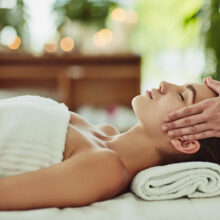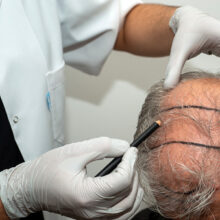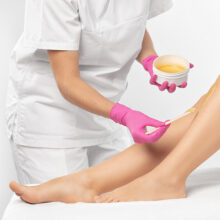5 Signs That Show Your Age & How to Reverse Them
- Published: Saturday, November 16th 2013
- in Beauty
It’s happened to most of us—we’ve peered into the mirror horrified at the first signs of crow’s feet; we finish an intense workout and our tired body refuses to rebound as it once did; we wake up following a good night’s sleep and still feel exhausted…ah, the infuriating joys of aging. Before we start to sound too cross, however, here are five age reversal tips the team at Pritikin Longevity Center + Spa in Miami, Florida, was kind enough to share with those of us seeking the Fountain of Youth.
Sign: Skin tone that has lost its youthful glow
Reversal: Eat more fruits and veggies
Scientists at Scotland’s University of St. Andrews recently discovered that more fruit-and-vegetable intake may lead to more attractive skin, shares Gayl Canfield, PhD, RD, director of nutrition at the Pritikin Longevity Center + Spa, referencing a six-week study that, among other components, measured the skin tone of each participant, all Caucasian college students, at different body locations.*
Results showed adding just one to two additional servings of fruits and vegetables a day produced more colorful, radiant skin appearance, with study leaders suspecting the “magic” elixir is the red, yellow, and orange pigments, called carotenoids, found within a great variety of fruits and veggies, Canfield adds.
“You can get these carotenoids and all their subsets, like lycopene and beta carotene, not only from red-, yellow-, and orange-hued produce like tomatoes and sweet potatoes but also from dark green vegetables, such as spinach,” Canfield says.
Scientists don’t know if similar improvements in skin attractiveness would be seen in people with other skin pigmentations, or in people older than college students, notes Canfield, though adds, “But it’s certainly worth a try!”
Sign: Puffiness in the face.
Reversal: Reduce dependence on medications via a healthy lifestyle
“A puffy or swollen face is essentially an accumulation of fluids that cause your face to appear more rounded and often inflamed (red faced). The causes are many and include sinusitis, a fever, and dehydration, but one common cause is medications, particularly blood pressure drugs,” explains Danine Fruge, MD, associate medical director at Pritikin.
At Pritikin, many people arrive taking pills for blood pressure, and often they’re puffy-faced and just plain tired-looking, Fruge continues. “But within three to four days, in response to the low-sodium/whole foods Pritikin diet and exercise program, their medications are being adjusted downward by our physicians, and they’re thrilled at what they’re seeing in the mirror—a thinner, much healthier-looking face.”
The bottom line? “The most effective solution for a healthy complexion and good overall health may in fact be the simplest one—the right foods and regular exercise, embodied in the Pritikin Program,” she tells us.
Sign: Flabby arms
Reversal: Strength training
“Imagine Michelle Obama-style arms on women in their 50s, 60s, and 70s—we see them every day here at the Pritikin Longevity Center,” says Scott Danberg, MS, Pritikin director of fitness. These Pritikin female “veterans,” who return to the center year after year, never skip the program’s signature strength training classes, Danberg reveals.
“The good news is there are several strength training exercises, such as triceps and kickbacks, that can help eliminate excess fat and loose skin in the arms,” he continues. “The other good news is that for many women, just 20 minutes three times a week does the trick.”
Sign: A creaky body
Reversal: Daily stretching
“In our 20s and 30s, it’s easy to forgo a regular stretching routine because, well, nothing creaks,” Danberg says. “But then, out of nowhere, you bend down to pick up a fallen fork—and can’t get up! Knees ache. Back muscles twinge. The whole body sighs. As the old saying goes, ‘I felt 21. Then I felt age.’” (My thoughts, exactly!)
Regular stretching, or flexibility, exercises can help take the “age” out of aging—the pain related to muscle tightness, Danberg tells us. Added benefits include improving your mobility and range of motion, plus, a more flexible body, which “greatly decreases your chance of injury from both daily and weekend activities.”
Pritikin guests stretch daily in fitness classes like Sunrise Stretch and tai chi; to do so at home, Danberg and team recommend stretching and flexibility activities include all major muscles in the body, and each stretch is held for at least a 20-count.
Sign: Daytime fatigue
Reversal: Make sure you’re getting enough sleep
“Some research indicates that no matter our age, we need fairly much the same amount of sleep that we needed in our 20s,” says Coral Arvon, PhD, director of behavioral health and wellness at Pritikin. “The difference, as we get older, may be that the total minutes of sleep are rearranged. For example, we may not be sleeping as many minutes at night, but we’ll be making up for those minutes throughout the day with naps, both scheduled (‘I take a nap every afternoon’) and unscheduled (falling asleep while watching TV).”
Do take time to meet your sleep needs, Arvon advises. “We need to change our mind-set and think of sleep as a gift. We need to think of poor-quality sleep, or insufficient sleep, as a curse. Because of poor-quality or poor-quantity sleep, we are often hit with problems like daytime fatigue or sleepiness, morning headaches, anxiety or depression, addiction to sleeping pills, increased risk of diabetes and other cardiovascular-related disease, and even trouble losing excess weight.
“With good-quality sleep, and plenty of it (optimally, seven to eight hours nightly), we enjoy the exact opposite, in summary, better health, better lives, happier lives. And we even boost, significantly so, our success in shedding excess weight because good sleep results in lower levels of hormones in our body that trigger appetite.”
*Whitehead RD, Re D, Xiao D, Ozakinci G, Perrett DI (2012) You Are What You Eat: Within-Subject Increases in Fruit and Vegetable Consumption Confer Beneficial Skin-Color Changes. PLoS ONE 7(3): e32988. doi:10.1371/journal.pone.0032988



